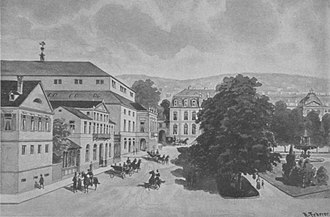The bell (Stuttgart)

The Glocke was an association of literary men in Stuttgart who met weekly between 1843 and 1849 in a hall in the garden of the Café Marquardt for social conversation and mutual communication of literary and artistic works.
society
The bell was founded in 1843 by the writers Friedrich Wilhelm Hackländer and Franz Dingelstedt . Hackländer was the secretary of Crown Prince Karl , and Dingelstedt was the reader and librarian of King Wilhelm . The association was "a humorous-literary Garçons society" "for art and art lovers for all sorts of amusement and amusemento, as it were an order of idleness and amusement".
The name of the association is explained by the fact that the organizational structure and the rituals of the association are based on the bell milieu. The society consisted "partly of artists, writers and scholars, partly of clever people of every possible class". The figurehead and protector of the association was the young Crown Prince, whose membership spurred many others to participate. Hugo Prinz zu Hohenlohe-Öhringen acted as the “bell master” , the “officials” were dubbed senior journeyman, hammer, coat, rope and handle, the treasurer was called bell bag and the other members were bell pullers.
In 1844, the association built its own restaurant on shares in the garden between the two individual buildings of Café Marquardt. The restaurant consisted of a spacious hall with a vaulted ceiling in the style of old bellhouses.
Members
In addition to the two founders and the Crown Prince, the association included everything "that was named in painting, poetry, architecture and other things with distinction", as well as members of "the best houses of the nobility interested in art and science, as well as high-ranking officials" .
Well-known members were the writers Emmanuel Geibel and August Lewald, the painters Heinrich Rustige and Jean Baptiste Zwecker, the architects Christian Friedrich von Leins and Karl Etzel and the composer Franz Liszt, who composed the federal song composed by Dingelstedt: “Heil our Glocke, Heil / Heil hammer, coat, rope / Heil our bell, Heil. "
literature
- Max Bach: Stuttgarter Kunst 1794-1860, based on simultaneous reports, letters and memories. Stuttgart: Adolf Bonz, 1900, pages 209-211.
- Otto Junker [= Otto Klenk]: The companies "Glocke" and "Bergwerk". A piece of club history from the 19th century. Munich: Meindl, 1930.
- Rudolf Krauss: Swabian Literature History. Volume 2: The Württemberg literature in the nineteenth century. Freiburg im Breisgau: Mohr, 1899, pages 428-430, 437.
- Rolf Parr: The bell. In: Wulf Wülfing; Karin Bruns; Rolf Parr: Handbook of literary-cultural associations, groups and leagues 1825–1933. Stuttgart: Metzler, 1998, pages 175-182.
Footnotes
- ↑ #Parr 1998.4 , p. 176.
- ↑ #Bach 1900 , page 210.
- ↑ #Bach 1900 , page 211.
- ↑ #Parr 1998.4 , pp. 176-177, 181.
Web links
Coordinates: 48 ° 46 ′ 46.2 " N , 9 ° 10 ′ 47.7" E

